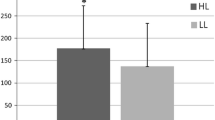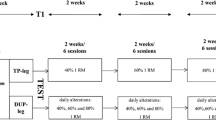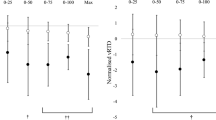Abstract
Purpose
Fatigability after gym-based resistance exercises with high and low loads has not been well described, thus limiting the translation of exhaustive low-weight prescription into athletic practice. We compared the fatigability and recovery of the knee extensor muscles for up to 1H after sessions that involved either high- or low-load resistance exercises.
Methods
16 trained men performed two resistance exercise sessions between 5 and 7 days apart. The LIGHT session involved five sets to task failure at 50% of maximal knee-extension strength, whereas the HEAVY session accrued repetitions across seven sets at intensities ≥ 80% maximal knee-extension strength. Measures of quadriceps maximal torque and rate of torque development were measured before, after, and 1H after each exercise session. Muscle activation (electromyography and voluntary activation) and contractility were measured from doublet stimulation of the femoral nerve during and after maximal contractions, respectively.
Results
Greater declines in maximal rate of torque development were observed after the LIGHT compared with the HEAVY session (p < 0.001), with full recovery after 1H. Voluntary activation (100-Hz doublet stimulation) and surface electromyograms were reduced immediately after the HEAVY session only (p < 0.05), with greater declines in quadriceps twitch amplitudes after the LIGHT session (p < 0.01). Voluntary activation (100-Hz doublet stimulation) was reduced at 1H after both the HEAVY and LIGHT sessions (p < 0.05).
Conclusions
Despite differences in the decreases in muscle activation and contractility after high- and low-load resistance-exercise sessions, recovery of neuromuscular function was essentially complete after 1H of rest for both sessions.

Similar content being viewed by others
Abbreviations
- 1H:
-
1-Hour measurement time-point
- ½ RT:
-
Half relaxation time
- ANOVA:
-
Analysis of variance
- BW:
-
Bodyweight
- M-wave:
-
Muscle compound action potential
- MVC:
-
Maximal voluntary contraction
- MVT:
-
Maximal voluntary torque
- PRE:
-
Measurement before exercise
- POST:
-
Measurement after exercise
- Q.pot.tw:
-
Quadriceps potentiated twitch
- 1-RM:
-
One repetition-maximum
- RMS:
-
Root-mean-square
- RTD:
-
Rate of voluntary torque development
- sEMG:
-
Surface electromyogram
- SD:
-
Standard deviation
- TPT:
-
Time to peak twitch
- VA:
-
Voluntary activation
- VL:
-
Vastus lateralis
- VM:
-
Vastus medialis
References
Aagaard P, Bojsen-Møller J, Lundbye-Jensen J (2020) Assessment of neuroplasticity with strength training. Exerc Sport Sci Rev 48:151–162
Amann M, Dempsey JA (2008) Locomotor muscle fatigue modifies central motor drive in healthy humans and imposes a limitation to exercise performance. J Physiol 586(1):161–173
Amann M, Romer LM, Subudhi AW, Pegelow DF, Dempsey JA (2007) Severity of arterial hypoxaemia affects the relative contributions of peripheral muscle fatigue to exercise performance in healthy humans. J Physiol 581(1):389–403
Behm DG, St-Pierre DMM, Perez D (1996) Muscle inactivation: assessment of interpolated twitch technique. J Appl Physiol 81:2267–2273
Behm DG, Reardon G, Fitzgerald J, Drinkwater E (2002) The effect of 5, 10, and 20 repetition maximums on the recovery of voluntary and evoked contractile properties. J Strength Cond Res 16(2):209–218
Besomi M, Hodges PW, Clancy EA, Van Dieën J, Hug F, Lowery M, Merletti R, Søgaard K, Wrigley T, Besier T, Carson RG, Disselhorst-Klug C, Enoka RM, Falla D, Farina D, Gandevia S, Holobar A, Kiernan MC, McGill K, Perreault E, Rothwell JC, Tucker K (2020) Consensus for experimental design in electromyography (CEDE) project: amplitude normalization matrix. J Electromyogr Kinesiol 53:102438. https://doi.org/10.1016/j.jelekin.2020.102438
Burnley M, Vanhatalo A, Jones A (2012) Distinct profiles of neuromuscular fatigue during muscle contractions below and above the critical torque in humans. J Appl Physiol 113:215–223
Campos GER, Luecke TJ, Wendeln HK, Toma K, Hagerman FC, Murray TF, Ragg KE, Ratamess NA, Kraemer WJ, Staron RS (2002) Muscular adaptations in response to three different resistance-training regimens: specificity of repetition maximum training zones. Eur J Appl Physiol 88:50–60
Carroll TJ, Riek S, Carson RG (2002) The sites of neural adaptation induced by resistance training in humans. J Physiol 544(2):641–652
Carroll TJ, Barton J, Hsu M, Lee M (2009) The effect of strength training on the force of twitches evoked by corticospinal stimulation in humans. Acta Physiol 197(2):161–173
Chiu L, Fry A, Schilling B, Johnson E, Weiss L (2004) Neuromuscular fatigue and potentiation following two successive high intensity resistance exercise sessions. Eur J Appl Physiol 92:385–392
Cross R, Siegler JC, Marshall PWM, Lovell R (2019) Scheduling of training and recovery during the in-season weekly micro-cycle: insights from team sport practitioners. Eur J Sports Sci. https://doi.org/10.1080/17461391.2019.1595740
Del Vecchio A, Negro F, Felici F, Farina D (2017) Associations between motor unit action potential parameters and surface EMG features. J Appl Physiol 123(4):835–843
Del Vecchio A, Negro F, Holobar A, Casolo A, Folland JP, Felici F, Farina D (2019) You are as fast as your motor neurons: Speed of recruitment and maximal discharge of motor neurons determine the maximal rate of force development in humans. J Physiol 597(9):2445–2456
Edwards RHT, Hill DK, Jones DA, Merton PA (1977) Fatigue of long duration in human skeletal muscle after exercise. J Physiol 272:769–778
Enoka RM, Duchateau J (2016) Translating fatigue to human performance. Med Sci Sports Exerc 48(11):2228–2238
Gandevia SC (2001) Spinal and supraspinal factors in human muscle fatigue. Physiol Rev 81(4):1725–1789
Gandevia SC, Allen GM, Butler JE, Taylor JL (1996) Supraspinal factors in human muscle fatigue: evidence for a suboptimal output from the motor cortex. J Physiol 512:595–602
Gauche E, Couturier A, Lepers R, Michaut A, Rabita G, Hausswirth C (2009) Neuromuscular fatigue following high versus low-intensity eccentric exercise of biceps brachii muscle. J Electromyogr Kinesiol 19(6):481–486
Gonzalez-Badillo J, Izquierdo M, Gorostiaga E (2006) Moderate volume of high relative training intensity produces greater strength gains compared with low and high volumes in competitive weightlifters. J Strength Cond Res 20(1):73–81
Gordon A, Homsher E, Regnier M (2000) Regulation of contraction in striated muscle. Physiol Rev 80:853–924
Jenkins NDM, Miramonti AA, Hill EC, Smith CM, Cochrane-Snyman KC, Housh TJ, Cramer JT (2017) Greater neural adaptations following high- vs. Low-load resistance training. Front Physiol. https://doi.org/10.3389/fphys.2017.00331
Johnson ST, Kipp K, Norcross MF, Hoffman MA (2015) Spinal and supraspinal motor control predictors of rate of torque development. Scand J Med Sci Sports 25(5):623–629
Jones TW, Smith A, Macnaughton LS, French DN (2016) Strength and conditioning and concurrent training practices in elite rugby union. J Strength Cond Res 30(12):3354–3366
Klemp A, Dolan C, Quiles JM, Blanco R, Zoeller RF, Graves S, Zourdos MC (2016) Volume-equated high- and low-repetition daily undulating programming strategies produce similar hypertrophy and strength adaptations. Appl Physiol Nutri Metab 41:699–705
Marshall PWM, Cross R, Lovell R (2015a) Passive heating following the prematch warm-up in soccer: examining the time-course of changes in muscle temperature and contractile function. Phys Rep 3(12):e12635
Marshall PWM, Finn HT, Siegler JC (2015b) The magnitude of peripheral muscle fatigue induced by high and low intensity single-joint exercise does not lead to central motor output reductions in resistance trained men. PLoS ONE 10(10):e0140108
Marshall PW, Cross R, Haynes M (2018) The fatigue of a full body resistance exercise session in trained men. J Sci Med Sports 21(4):422–426
Marshall PW, Metcalf E, Hagstrom AD, Cross R, Siegler JC, Enoka RM (2020a) Changes in fatigue are the same for trained men and women after resistance exercise. Med Sci Sports Exerc 52(1):196–204
Marshall PW, Rasmussen SB, Krogh M, Halley SL, Siegler JC (2020b) Changes in the quadriceps spinal reflex pathway after repeated sprint cycling are not influenced by ischemic preconditioning. Eur J Appl Physiol 120(5):1189–1202
Marshall PW, Finn HT, Enoka RM (2021) Declines in muscle contractility and activation during isometric contractions of the knee extensors vary with contraction intensity and exercise volume. Exp Physiol. https://doi.org/10.1113/EP089788
McCaulley GO, McBride JM, Cormie P, Hudson MB, Nuzzo JL, Quindry JC, Travis Triplett N (2009) Acute hormonal and neuromuscular responses to hypertrophy, strength and power type resistance exercise. Eur J Appl Physiol 105(5):695–704
Melville GW, Siegler JC, Marshall PW (2017) The effects of d-aspartic acid supplementation in resistance-trained men over a three month training period: a randomised controlled trial. PLoS ONE 12(8):e0182630
Metcalf E, Hagstrom AD, Marshall PW (2019) Trained females exhibit less fatigability than trained males after a heavy knee extensor resistance exercise session. Eur J Appl Physiol 119(1):181–190
Mitchell CJ, Churchward-Venne TA, West DW, Burd NA, Breen L, Baker SK, Phillips SM (2012) Resistance exercise load does not determine training-mediated hypertrophic gains in young men. J Appl Physiol 13(1):71–77
Morton RW, Oikawa SY, Wavell CG, Mazara N, McGlory C, Quadrilatero J, Baechler BL, Baker SK, Phillips SM (2016) Neither load nor systemic hormones determine resistance training-mediated hypertrophy or strength gains in resistance-trained young men. J Appl Physiol 121(1):129–138
Morton RW, Sonne MW, Zuniga AF, Mohammad IYZ, Jones A, McGlory C, Keir PJ, Potvin JR, Phillips SM (2019) Muscle fibre activation is unaffected by load and repetition duration when resistance exercise is performed to task failure. J Physiol 597(17):4601–4613
Schoenfeld B, Contreras B, Willardson JM, Fontana F, Tiryaki-Sonmez G (2014) Muscle activation during low- versus high-load resistance training in well-trained men. Eur J Appl Physiol 114(12):2491–2497
Schoenfeld B, Petersen MD, Ogborn D, Contreras B, Sonmez GT (2015) Effects of low vs high-load resistance training on muscle strength and hypertrophy in well-trained men. J Strength Cond Res 29(10):2954
Sidhu SK, Weavil JC, Thurston TS, Rosenberger D, Jessop JE, Wang E, Richardson RS, McNeil CJ, Amann M (2018) Fatigue-related group III/IV muscle afferent feedback facilitates intracortical inhibition during locomotor exercise. J Physiol 596(19):4789–4801
Siegler JC, Marshall PWM, Poulsen MK, Nielsen NP, Kennedy D, Green S (2015) The effect of pH on fatigue during submaximal isometric contractions of the human calf muscle. Eur J Appl Physiol 115(3):565–577
Siegler JC, Marshall PW, Finn HT, Cross R, Mudie K (2018) Acute attenuation of fatigue after sodium bicarbonate supplementation does not manifest into greater training adaptations after 10-weeks of resistance training exercise. PLoS ONE 13(5):e0196677
Storey A, Smith HK (2012) Unique aspects of competitive weightlifting: performance, training and physiology. Sports Med 42(9):769–790
Storey A, Wong S, Smith HK, Marshall PW (2012) Divergent muscle functional and architectural responses to two successive high intensity resistance exercise sessions in competitive weightlifters and resistance trained adults. Eur J Appl Physiol 112(10):3629–3639
Strojnik V, Komi PV (1998) Neuromuscular fatigue after maximal stretch-shortening cycle exercise. J Appl Physiol 84(1):344–350
Thomas K, Goodall S, Howatson G (2018) Performance fatigability is not regulated to a peripheral critical threshold. Exerc Sports Sci Rev 46(4):240–246
Van Cutsem M, Duchateau J, Hainaut K (1998) Changes in single motor unit behaviour contribute to the increase in contraction speed after dynamic training in humans. J Physiol 513:295–305
Weavil JC, Amann M (2018) Corticospinal excitability during fatiguing whole body exercise. Prog Brain Res 240:219–246
Weavil JC, Sidhu SK, Mangum TS, Richardson RS, Amann M (2016) Fatigue diminishes motoneuronal excitability during cycling exercise. J Neurophysiol 116:1743–1751
Westerblad H, Duty S, Allen DG (1993) Intracellular calcium concentration during low-frequency fatigue in isolated single fibers of mouse skeletal muscle. J Appl Physiol 75:382–388
Yoon T, Delap BS, Griffith EE, Hunter SK (2007) Mechanisms of fatigue differ after low- and high-force fatiguing contractions in men and women. Muscle Nerve 36:515–524
Acknowledgements
No funding was received by any author to support this project.
Author information
Authors and Affiliations
Contributions
PM conceived and designed the research, TF and PM conducted the experiments. PM, TF, and RE processed and analysed the data. All authors contributed to the final editing and revision of the manuscript. All authors have read and approved the final manuscript.
Corresponding author
Ethics declarations
Conflict of interest
The authors have declared no conflicts of interest.
Additional information
Communicated by Andrew Cresswell.
Publisher's Note
Springer Nature remains neutral with regard to jurisdictional claims in published maps and institutional affiliations.
Rights and permissions
About this article
Cite this article
Marshall, P.W., Forward, T. & Enoka, R.M. Fatigability of the knee extensors following high- and low-load resistance exercise sessions in trained men. Eur J Appl Physiol 122, 245–254 (2022). https://doi.org/10.1007/s00421-021-04832-z
Received:
Accepted:
Published:
Issue Date:
DOI: https://doi.org/10.1007/s00421-021-04832-z




